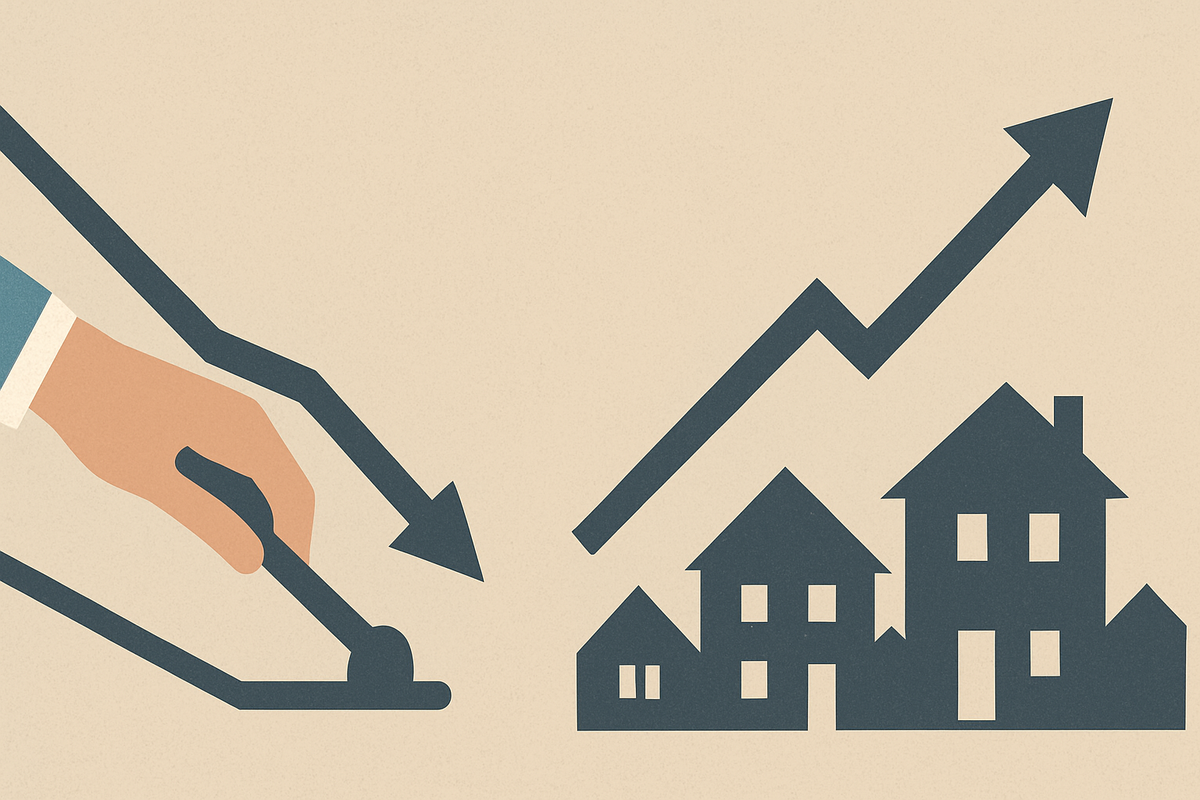Financial News
The Great Mortgage Rate Mystery: Why Fed Cuts Aren't Cooling Home Loans

As of late 2025, a puzzling disconnect has emerged in the financial markets, leaving homebuyers and investors grappling with a 'new reality.' Despite the Federal Reserve initiating a series of rate cuts, the anticipated relief in mortgage rates has largely failed to materialize. This unforeseen divergence challenges conventional economic wisdom, where lower benchmark interest rates typically translate into more affordable long-term borrowing costs, and its immediate implications are reshaping the landscape for aspiring homeowners and the broader housing market.
This persistent elevation of mortgage rates, even in an environment of easing monetary policy, presents a significant hurdle for housing affordability. While the Fed's actions aim to stimulate economic activity by making borrowing cheaper, the stubbornly high cost of home loans continues to sideline potential buyers, dampening demand and creating a unique set of challenges for real estate developers, lenders, and consumers alike. The market is now forced to confront a complex interplay of factors that are preventing the traditional transmission mechanism of monetary policy from reaching the housing sector.
The Stubborn Grip: Unpacking the Mortgage Rate Disconnect
The conventional wisdom that Federal Reserve rate cuts automatically translate into cheaper mortgages has been thoroughly challenged in late 2025. While the Federal Reserve implemented its first interest rate cut of the year on September 17, reducing the federal funds rate by 25 basis points to a range of 4.00% to 4.25%, the average 30-year fixed-rate mortgage, after a brief dip to a three-year low of 6.13% in late September, quickly climbed back to 6.34% by early October 2025. This perplexing behavior highlights a complex interplay of forces beyond the Fed's direct control.
The primary driver of long-term fixed mortgage rates is not the federal funds rate, but rather the yield on the 10-year U.S. Treasury note. Mortgage lenders typically price their loans by adding a spread (historically 2-3%) on top of this benchmark. Even if the Fed cuts its short-term rate, if the bond market, influenced by expectations of future inflation or robust economic growth, keeps the 10-year Treasury yield elevated, mortgage rates will follow suit. Persistent inflation expectations, despite some cooling, remain a significant factor, as lenders demand higher returns to compensate for the erosion of purchasing power over time.
Adding to this complexity are the dynamics of the Mortgage-Backed Securities (MBS) market and the Federal Reserve's ongoing Quantitative Tightening (QT) policy. During periods of quantitative easing, the Fed was a major buyer of MBS, helping to suppress yields and keep mortgage rates low. However, with QT, the Fed is shrinking its balance sheet by allowing these assets to mature without reinvestment, thereby reducing liquidity and putting upward pressure on long-term rates. This effectively works against the downward pressure that short-term rate cuts might otherwise exert. Furthermore, mortgage lenders themselves, facing reduced loan volumes and increased operational costs, may maintain wider profit margins, further contributing to higher rates.
Key players in this scenario include the Federal Reserve, which, through Chair Jerome Powell, has emphasized a data-dependent approach to future rate decisions, indicating a cautious stance despite recent cuts. Mortgage lenders, such as Rocket Companies (NYSE: RKT) and United Wholesale Mortgage (NYSE: UWMC), are grappling with pipeline volatility, with a significant percentage of deals collapsing due to high interest rates and buyer hesitation. Homebuyers, meanwhile, face a market where high home prices combined with elevated rates create a severe affordability crisis, leading many to delay purchases or seek alternative financing strategies, such as adjustable-rate mortgages (ARMs) or seller concessions. The market is thus in a delicate state of rebalancing, with significant challenges for all involved.
Navigating the Headwinds: Winners and Losers in the High-Rate Environment
The sustained disconnect between Federal Reserve rate cuts and stubbornly high mortgage rates in late 2025 is creating a bifurcated market, producing clear winners and losers among public companies in the housing and financial sectors. Companies with direct exposure to mortgage originations and home sales are facing significant headwinds, while those catering to the rental market or home improvement are finding relative resilience.
Homebuilders, including industry giants like Lennar (NYSE: LEN), D.R. Horton (NYSE: DHI), and PulteGroup (NYSE: PHM), are among those most affected. High mortgage rates shrink the pool of eligible buyers, leading to reduced demand for new homes. This translates directly into fewer sales, necessitating increased incentives or even price adjustments to move inventory, thereby compressing profit margins. Companies like KB Home (NYSE: KBH) have already seen stock downgrades reflecting concerns over market volatility and dampened buyer interest. Homebuilders are adapting by focusing on smaller, more affordable homes and offering mortgage rate buydowns to attract buyers.
Real estate brokerages, such as Redfin Corporation (NASDAQ: RDFN) and Douglas Elliman Inc. (NYSE: DOUG), are also feeling the pinch. The "lock-in effect," where homeowners with historically low mortgage rates are reluctant to sell and take on a new, higher-rate mortgage, severely constrains the supply of existing homes. Fewer transactions mean reduced commission income, directly impacting their top-line revenue and profitability. Mortgage lenders, including the aforementioned Rocket Companies (NYSE: RKT) and United Wholesale Mortgage (NYSE: UWMC), are experiencing a dramatic drop in loan origination volumes, both for purchases and refinancing, directly hitting their primary revenue streams. Regional banks with significant exposure to commercial real estate (CRE) are also at risk, as higher borrowing costs can reduce property values and complicate debt refinancing, potentially leading to increased non-performing loans.
Conversely, certain sectors are proving more resilient or even benefiting from this environment. Residential Real Estate Investment Trusts (REITs) focused on rental properties, such as Equity Residential (NYSE: EQR) and AvalonBay Communities (NYSE: AVB), are poised to gain. As homeownership becomes less accessible, demand for rental housing increases, leading to higher occupancy rates and stronger rental pricing power. Companies in the home improvement and renovation sector, like Home Depot (NYSE: HD) and Lowe's (NYSE: LOW), could also see a boost. The "lock-in effect" means homeowners are more likely to renovate their current homes rather than move, driving demand for building materials and services. Diversified banks like JPMorgan Chase (NYSE: JPM), with strong wealth management and investment banking arms, are better positioned to weather the storm, as they can offset sluggish mortgage lending with other revenue streams, and may even see bright spots in M&A activity if market conditions improve. Mortgage servicers, while not immune to market shifts, may find their servicing rights on existing loans become more valuable due to reduced prepayment risk in a high-rate environment.
A New Economic Reality: Broader Trends and Policy Implications
The persistent disconnect between Federal Reserve rate cuts and stubbornly high mortgage rates in late 2025 is more than a fleeting market anomaly; it signifies a profound shift in the economic landscape with far-reaching implications for broader industry trends, regulatory frameworks, and historical comparisons. This 'new reality' underscores that the housing market is influenced by a complex web of factors beyond just short-term monetary policy.
At its core, this situation exacerbates the ongoing housing affordability crisis. Elevated mortgage rates, coupled with already high home prices, effectively price out millions of households, particularly first-time homebuyers. This deepens a crisis rooted in chronic housing shortages, restrictive zoning laws, and stagnant wage growth relative to housing costs. The result is a widening wealth gap, where homeownership becomes an increasingly distant dream for many, while those who own homes with low fixed rates are incentivized to stay put, further constraining inventory.
This environment is also driving a significant shift in investment patterns. Higher borrowing costs diminish the attractiveness of real estate as a direct investment, leading investors to seek better yields elsewhere. The market is increasingly dominated by all-cash buyers, often wealthy individuals or institutional investors, who gain a competitive edge in a high-rate environment. This further marginalizes mortgage-reliant buyers and contributes to the "lock-in effect" on existing homeowners, who are reluctant to sell their homes and trade their low rates for significantly higher current ones.
The ripple effects extend across the entire housing ecosystem. Mortgage lenders face reduced origination volumes and increased competition, potentially leading to industry consolidation. Real estate agents see fewer transactions and lower commissions. Homebuilders and construction companies grapple with diminished demand for new builds and renovations. Conversely, the rental market experiences heightened demand, leading to increased occupancy rates and potentially stronger rent growth for residential REITs. This dynamic underscores the interconnectedness of the housing and financial sectors, where a slowdown in one area can cascade through others, ultimately impacting consumer sentiment and overall economic growth, given that the housing sector accounts for 15-18% of the U.S. GDP.
Historically, a direct one-to-one relationship between Fed rate cuts and mortgage rate declines has been uncommon. The 1980s, under Paul Volcker, saw mortgage rates remain stubbornly high for a period even after the Fed began cutting rates, as markets took time to believe inflation was truly subdued. Similarly, after the 2001 recession and during the Global Financial Crisis (2007-2009), mortgage rates did not fall proportionally to the Fed's drastic rate cuts, primarily due to market dysfunction, heightened risk aversion, and persistent inflation expectations. These precedents highlight that long-term mortgage rates are ultimately determined by a confluence of factors, particularly inflation expectations and broader economic outlook, which can temper or even counteract the impact of short-term rate adjustments. This current situation in late 2025 appears to fit into this historical pattern, driven by ongoing inflation concerns, resilient economic growth, and structural issues within the housing market.
The Road Ahead: Scenarios and Strategic Adaptations
As the housing market grapples with the 'new reality' of disconnected rates, stakeholders must prepare for a complex and evolving landscape in the short and long term. While the immediate future (late 2025) suggests continued challenges, strategic adaptations and emerging opportunities will define the trajectory of the housing market and broader economy.
In the short term, the affordability crisis will persist, with high mortgage rates and elevated home prices continuing to sideline many prospective buyers. Housing activity and sales volumes are expected to remain subdued, though inventory levels are showing gradual improvement, offering buyers slightly more choice. Home prices, while stabilizing, will remain elevated, with modest growth nationally and potential regional corrections. The dominance of all-cash buyers is likely to continue, further skewing market dynamics. Looking further ahead, into late 2026 and beyond, a gradual moderation of mortgage rates is anticipated, potentially reaching the mid-5% to low-6% range, contingent on consistent disinflation and a moderate economic slowdown. This would eventually improve affordability, though a swift return to pre-pandemic low rates is not expected for several years.
Strategic pivots are crucial for all market participants. Homebuyers should prioritize overall affordability over chasing specific low rates, considering adjustable-rate mortgages (ARMs) for initial savings or negotiating seller concessions like mortgage rate buydowns. Improving credit scores and exploring down payment assistance programs will also be vital. For lenders, adapting to lower loan volumes by offering flexible products, focusing on niche markets, and carefully managing risk will be key. Homebuilders must adjust pricing and product mixes, offering incentives and focusing on more affordable housing options to attract buyers in a competitive environment, while navigating regulatory hurdles and material costs.
Emerging market opportunities include a potential future refinancing boom when rates eventually fall, creating significant business for lenders. Niche housing markets, such as those catering to senior citizens, may also see increased demand. For diversified investors, non-agency residential mortgage bonds could become attractive due to elevated home equity and incremental yields. However, significant challenges remain, including the enduring affordability crisis, persistent inventory shortages due to the "rate lock-in effect," and the potential for rising construction costs. Economic uncertainty, global policy shifts, and the possibility of a segmented market where luxury homes continue to appreciate while entry-level homes decline also pose risks.
Potential scenarios for the coming years range from modest, sustained price growth driven by strong job markets and demographic demand, to price stabilization if inventory significantly improves, or even regional price corrections in specific areas. A "higher-for-longer" mortgage rate environment (6.5%-7.5% through much of 2025-2027) remains a possibility if inflation proves stubborn or economic growth robust. Conversely, a "soft landing" scenario, with gradual rate declines into the mid-5% range by late 2026, could unfold if inflation eases as expected. The market's future will largely depend on the interplay of these complex factors, requiring continuous monitoring and adaptable strategies from all stakeholders.
The Enduring Impact of Disconnected Rates: A Market Reimagined
The year 2025 marks a pivotal moment in the financial landscape, characterized by the perplexing reality that Federal Reserve rate cuts are not translating into a corresponding decline in mortgage rates. This "new reality" is not a temporary blip but rather a complex interplay of persistent inflation expectations, the independent dynamics of the 10-year Treasury yield, the Fed's quantitative tightening, and the strategic positioning of lenders. The key takeaway is clear: the housing market is operating under a different set of rules, where the Fed's short-term policy has a less direct and immediate impact on long-term borrowing costs than conventionally assumed.
Moving forward, the market will continue to be defined by this disconnect, with 30-year fixed mortgage rates likely to hover in the mid-6% range through much of 2025, with only gradual moderation anticipated into 2026 and beyond. Home price appreciation will be modest and localized, while inventory levels, though improving, will remain constrained by the "lock-in effect." The enduring affordability crisis will reshape homebuyer behavior, pushing many towards rental markets or requiring creative financing solutions and a willingness to accept higher rates as the new norm. This dynamic will continue to favor cash buyers and institutional investors, further segmenting the market.
The lasting impact of this period will be a reimagined housing market and a re-evaluation of monetary policy's reach. It underscores the limitations of the Federal Reserve's direct influence on long-term rates when faced with strong inflationary pressures and robust bond market dynamics. For the broader economy, a constrained housing market can dampen consumer spending and overall growth, even as other sectors might benefit from a resilient economy. The era of ultra-low mortgage rates appears firmly in the rearview mirror, ushering in a period where strategic adaptation, financial prudence, and a deep understanding of market fundamentals will be paramount.
Investors should closely watch several key indicators in the coming months: inflation data and the 10-year Treasury yield for signs of sustained disinflation; the Federal Reserve's communications for clues on future policy direction, differentiating between short-term rate cuts and long-term market influence; and regional housing market dynamics, as performance will vary significantly. Furthermore, monitoring new housing construction, supply-side reforms, and any potential government interventions or policy shifts will be crucial. The ability to navigate this complex, disconnected environment will determine success, as the market settles into what promises to be a prolonged period of elevated, albeit stabilizing, borrowing costs.
This content is intended for informational purposes only and is not financial advice
More News
View More




Recent Quotes
View More
Quotes delayed at least 20 minutes.
By accessing this page, you agree to the Privacy Policy and Terms Of Service.



